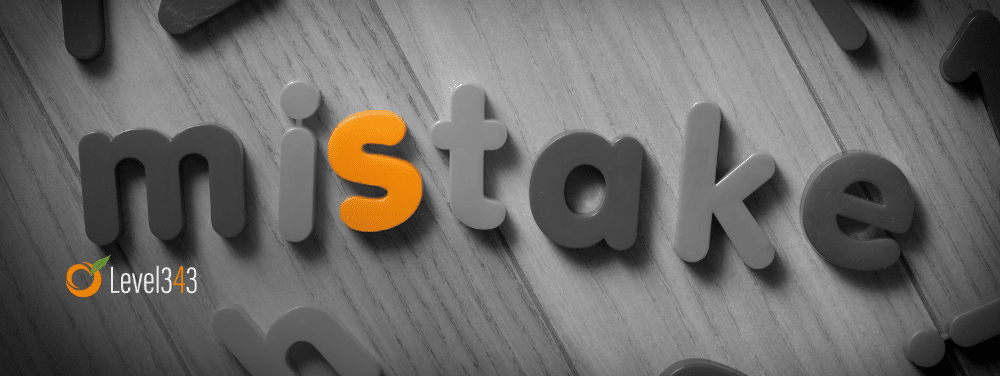As business owners and marketing directors, there is no doubt that the success of your company relies heavily on the effective implementation of SEO, and realizing when you’re making SEO mistakes.
However, despite all of our advancements in technology and understanding, there are still a handful of common SEO mistakes being made when it comes to optimizing pages search engine visibility. Unfortunately, these oversights cause problems for businesses who could be achieving greater online visibility – leading many to miss out on profitable opportunities without even knowing it.
In 2014, the Internet reached over 1 billion websites. One billion – can you believe it? I guess I’ve been in marketing too long; instead of just being in awe at the sheer amount of information (or misinformation), I just think, “Man, that’s a lot of competition!”
I think I can count on one hand how many clients have come to me that didn’t have competition in one way or another, and all of them were cutting edge companies. Chances are your website has hundreds of competitors, at least, and eCommerce sites have thousands.
What am I getting at?
When you’re bombarded with competition, the only way to win is to take advantage of every opportunity you can. One such opportunity is optimization. However, while a lot of business owners have caught up with the benefits of SEO, many are making mistakes in their websites that cost them those benefits.
Let’s look at a few of the most common.
Common SEO Mistakes Still Being Made
The basis for this post was originally written in 2008. Surprisingly, many of the same SEO mistakes mentioned in the original post can still be found today. It makes me want to scream, “Don’t you know times change?” Times change, and so do people. Your target market isn’t the same as it was 10 years ago. For one, it’s much more online savvy. For two, it’s much more mobile. These two basic truths have CHANGED the way we market, or they should have. Here are a few surprisingly common ways that ignore time, change, and good marketing sense.
If you’re guilty of any of the below, contact us for an audit. You’ve missed some essential updates to how marketing has changed, and your website is suffering for it!
1. Using images instead of text
Typography is wonderful, and beautiful pictures are wonderful. Beautiful typography is absolutely awesome, and it looks great for a term paper or if you’re designing a logo for a website project. But.
While we say, “do for the users first,” you still have to remember search engines. Search engines can’t look at a picture of a pickle (yet) and say, “Oh, that’s about pickles. Let’s rank that with pickles.” If you use images to show important text, you’re losing out on a major SEO opportunity.
The other issue is, what if the image doesn’t show? From a user perspective, it looks pretty bad – especially if that image is in an important place. I’ve seen images used for headlines, page titles, bullet points, and more. I have actually seen whole web pages built as a picture. -And I don’t mean a few years ago, I mean recently. Sure it appears good to the viewer, but as far as the search engine is concerned, that is a blank page.
Finally, when using images, give a thought to the reader and use the right size. There are two “right sizes.” One is DPI, or Dots per Inch. Some graphics are created in 300 dpi and then uploaded to the web (these are usually created, not just photos. Think logos, for example.) While this makes them all bright and shiny, that high of a resolution is best for print. For the web, 72 dpi is sufficient for most things.
The second is actual image size: 1024 x 768, 500 x 400, etc. The “right size” for your purpose depends on what you need it for. For example, the image on this post is showing at 300 x 273. If you were to download the picture, it would still be 300 x 273. On Which Content Metrics Should I Be Using To Track My Campaign? what you see is 690 x 460. If you were to download the image, it’d be 800 x 534… yes, I need to shrink the image down.
Why is this a big deal?
What usually happens is blog owners download a stock image. That image is something like 2200 x 1528 or 5648 x 3280… big numbers. These are huge images, and they are big files. Big files take longer to load and weigh the page down. The poor people with slower internet pay the price, as well as people on mobile with limited minutes. By reducing the size to only what’s needed, you save on size, bandwidth and how long it takes to view the image. Win, win, win!
A few tips for using images on a website:
- Only use images when it enhances the website.
- Never use images for important text
- Use images that are the right size (rather than too large and then shrink them)
- Always include alternative text (helps search engines understand what the image is about)
2. Making use of a splash page
The first page of any web site is the most significant page. That’s number one, and search engines normally run through it. But what a lot of people seem to forget sometimes people don’t land on your home page… And yet, many people use their home page for a pretty picture or fancy artwork. I’ve seen pages that were blank except for a sign that said “Enter.” Yes… yes… I can see search engines ranking that page for… nothing. Because there’s nothing on it.
There’s a reason why, when you look at your analytics, that the home page almost always brings in the most traffic. Because that’s where most people first come in contact with your site. This is an absolute prime piece of website real estate, and you can’t afford to take it lightly. If you want the number one SEO mistake a lot of clients seem to engage in, the splash pages, avoid those if at all possible!
Exception to this rule:
We do a lot of international marketing, so I’m very aware of a caveat to this. Some website with multiple languages use a splash page to give the visitor a choice in language. This is all good and well, but don’t just offer languages. Provide content in your company’s home language (or the language of your largest user base) that at least introduces the site and what you have to offer. Don’t waste this space with “enter”!
3. Not placing the description tags and title on the pages
Right. So here, I can hear you say, “Oh, come on, Gabriella. Everybody knows to use the description tag and titles by now. That’s a given.”
It’s not. No. No. It’s really not.
I still occasionally come across pages that say “New Page,” because someone didn’t fill in the title tag. More often, though, I see the name of the page. For example, “About,” because that’s the page’s internal name. And then you view source to see the description and you see:
<meta name=”description” content=””/>
Again, this is an excellent opportunity or a wasted one. Do yourself a favor and read “10 Building Blocks of Great Meta Tags“. Meta tags matter, and not just for search engines and SEO!
4. Using the same descriptions and title
While some don’t use them at all, others are lazy with them. It’s a copy/paste sort of thing.
Each web page is unique and has a particular function. Show the search engine and the users what your page is about by changing the description tags and the title to adhere to the content on that specific web page. It’s a little difficult to optimize a single page for several varied search terms, but it’s easier to optimize each of the web site pages for one or two crucial search phrases.
Let me ask you a question. If all you had to go on was the content in your meta tags, would YOU buy from you? What if you saw your search snippet for the last article or web page you published, would it entice you to click to the site?
If you can’t say yes, you need to revisit this important section of your website.
5. More terms than content
There is such a thing as keyword stuffing. It’s obvious, and it sucks. Keyword stuffing can turn an awesome piece of content into something even a cat wouldn’t bury. How do you use keywords, terms and phrases correctly?
Think of the user. BE the user. Read through the piece of content you just finished, and think, “Would I want to read this?”
The biggest key is to use the term naturally. Only put it where it fits. If you have to force it to fit into the content, you’re either using the wrong term or using the wrong content. One way to find out which is to write your article and then do a word check. Find out which words show up the most. Whatever words those are is what the content is about.
For instance, in this article, the top three terms are: search engines, web page, and meta tags. Not bad for a topic about SEO.
Final Thoughts
Times change, people. Your user base is ten years older than they were in 2007, and way more savvy than they used to be. Technology has changed, users have changed, marketing has changed. If you haven’t looked at your website for the past ten years, I guarantee there are some areas that could do with an upgrade. -And if you’re making these SEO mistakes, don’t you think it’s time?







































